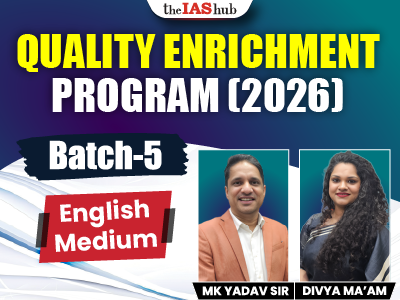
President’s Rule imposed in Manipur: Indian President recently issued a proclamation under Article 356 of the Constitution after receiving a report from Governor
About: The State Emergency is imposed under Article 356 when a state’s constitutional machinery fails. It allows the central government to take direct control of state governance.
Constitutional Provisions: Union must protect states from external aggression & internal disturbances (Article 355) → President can take over a state’s functions if its government fails constitutionally (Article 356) → Allows President to legislate for the state through ordinances (Article 357) → If a state fails to follow the Centre’s directions, the President can assume control (Article 365).
Parliamentary Approval & Duration: As per Article 356(3), the proclamation must be approved by both Houses of Parliament within two months, else it will cease to operate.
Supreme Court Judgments on President’s Rule: S.R. Bommai Case (1994) & Rameshwar Prasad Case (2006)
Key Recommendations by Commissions: Sarkaria Commission & Punchhi Commission
Previous President’s Rule in Manipur: Last imposed from June 2, 2001, to March 6, 2002 (277 days).

Crisis in the Democratic Republic of Congo (DRC): M23 militia, backed by Rwanda, has captured Goma, a mineral-rich city on the DRC-Rwanda border.
As per the UN estimates approx. 2,900+ killed, 700,000 displaced, many injured (since January).
About Democratic Republic of the Congo: A country in Central Africa. By land area, the DRC is the second-largest country in Africa and the 11th-largest in the world.
Nile River: World’s longest river, flowing through 11 countries, crucial for ancient civilizations & development.
Rwandan Genocide (1994): Tutsi repression under Hutu rule led to the formation of the Rwandan Patriotic Front (RPF), triggering a civil war (1990) → Rwandan invasions of DRC (1996, 1998) led to Africa’s World Wars: First Congo War (1996) & Second Congo War (1998-2003).
About M23 Rebels: Formed in 2012, named after March 23, 2009 agreement between DRC & Tutsi-led CNDP.
Uganda’s stance: Supports Congolese troops hunting IS-linked militants which allows M23 to use its territory (as per UN reports).

Amrit Bharat Station Scheme (ABSS): Over ₹12,000 crore allocated for station redevelopment in FY 2025-26 under the Amrit Bharat Station Scheme.
About ABSS: Launched in February 2023 by the Ministry of Railways to redevelop railway stations across India → Focuses on continuous, phased development with master plans tailored to each station’s needs → Aims to modernize stations with improved passenger amenities, traffic flow, inter-modal integration, and signage → Introduces new amenities while upgrading/replacing existing ones → Envisions stations as vibrant city centres with modern infrastructure.
Key Features of ABSS: Modern Passenger Amenities → Improved Traffic Circulation → Inter-Modal Integration → Upgraded Signage → Sustainability Measures → Eco-Friendly Initiatives
Priority Stations: 80 major stations like Gorakhpur, Lucknow (Charbagh), Prayagraj, CST, Muzaffarpur under continuous monitoring.
Implementation Models: Engineering, Procurement, and Construction (EPC) Model & PPP Mode (Used for 20 key stations like Pune, Delhi Junction, Vijayawada, Chennai Central)

Indian Nano Satellite-1C (INS-1C): As per the ISRO officials, a miniature multi-spectral technology demonstration (MMX-TD) camera on-board INS-1C is sending high-resolution images of Earth.

Bar Council of India: Recently, the Union government proposed an amendment to the Advocates Act, 1961.
About: The Bar Council of India is a statutory body that regulates and represents the Indian bar, was created by Parliament under the Advocates Act, 1961.
Structure of the Bar Council of India: Consists of 18 Members.
About Key Provisions of the Draft Advocates (Amendment) Bill, 2025
Prohibition on Lawyer Strikes: Under New Section 35A, advocates cannot call for boycotts or abstain from court work, nor cause obstruction in court functioning.
Violation = Misconduct: Punishable under the Act and regulations.
Exception: Advocates may strike only if it does not disrupt justice, e.g., symbolic or one-day token strikes for professional concerns.
Government Nominees in Bar Council of India (BCI): Centre can nominate up to three members to BCI (Section 4).
Existing Members: Attorney General, Solicitor General, and one member from each State Bar Council.
Power of the Central Government (New Section 49B): Centre can direct BCI on matters necessary for executing provisions of the Act or related rules.

Neutrino: Recently, Scientists detected a high-energy neutrino using an observatory under construction deep beneath the Mediterranean Sea near Sicily.
About: Neutrinos are undisturbed by magnetic fields and rarely interact with matter, making them “cosmic messengers” that can be traced back to their source.
Unlike cosmic rays, whose paths are altered by magnetic fields, neutrinos travel in straight lines, making them more reliable messengers.
Detecting neutrinos is complex, requiring large observatories deep underwater or in ice to detect their interactions with matter.
High-energy neutrinos are produced by extreme astrophysical events like: Black holes consuming matter → Gamma-ray bursts from star explosions → Cosmic rays interacting with background radiation.

Sovereign Green Bonds (SGrBs): India’s efforts to finance green investments through Sovereign Green Bonds (SGrBs) face low investor demand, limiting the government’s ability to secure a green premium (lower yields than regular bonds).
About Green Bond: It issued by any sovereign entity, inter-governmental groups or alliances and corporates with the aim that the proceeds of the bonds are utilised for projects classified as environmentally sustainable.
They are financial instruments that finance green projects and provide investors with regular or fixed income payments, announced in the Union Budget 2022-23.
First ever green bond: Issued by the World Bank in 2008.
Significance: Importance financial instrument has emerged as an important financial instrument to deal with the threats of climate change and related challenges.

QUAD: India and the US announced new QUAD initiatives and launched the Indian Ocean Strategic Venture.
Quad Initiatives refer to the Leaders to activate new partnerships in the Western Indian Ocean, Middle East, and Indo-Pacific.
About QUAD: Strategic forum of USA, Japan, India, and Australia.
Objective: Promote regional security, economic cooperation, and a free & open Indo-Pacific.
Key Focus Areas: Democracy, human rights, rule of law, countering China’s influence.
Genesis & Evolution:


Refine your answer writing skills and elevate your UPSC preparation with personalized support and expert feedback.
Fill out the form to get started with the program or any other enquiries !








Are you dreaming of becoming an IAS officer? Then, IAShub can be your best guide. It is one of the Best IAS Coaching in Delhi. Many students who want to clear the UPSC exam join IAShub for learning. The institute gives both online and offline classes. Their teachers are experienced and helpful. They easily explain every topic. Students also get notes, tests, and tips to do well in the exam.
IAShub is in Delhi and is trusted by many UPSC students. It offers coaching for every part of the UPSC exam – Prelims, Mains, and Interview. The classes are simple and easy to understand. The teachers are experts and guide students in the right way. IAShub is also known for its helpful notes, test series, and answer-writing practice. IAShub is the best coaching in Delhi and also gives UPSC Online Classes. This helps students from any place in India to learn. The online classes are live and also recorded. So, students can watch them anytime. These classes cover the full UPSC syllabus.
Here are some important services provided by IAShub:
The UPSC Civil Services Exam has three parts:
This exam is tough, but with the right guidance, it becomes easy to manage. Students must study smart and stay regular.
IAShub supports students from the beginning to the end. It gives the right books, tests, and notes. The classes are easy to follow, and the teachers are always ready to help. Students get personal doubt sessions too. The test series and answer checking help students learn where they need to do better. Also, free study materials save time and money.
IAShub also guides students during the final stage – the interview. Experts take mock interviews and give useful tips. This full support makes IAShub one of the best IAS coaching in Delhi.
